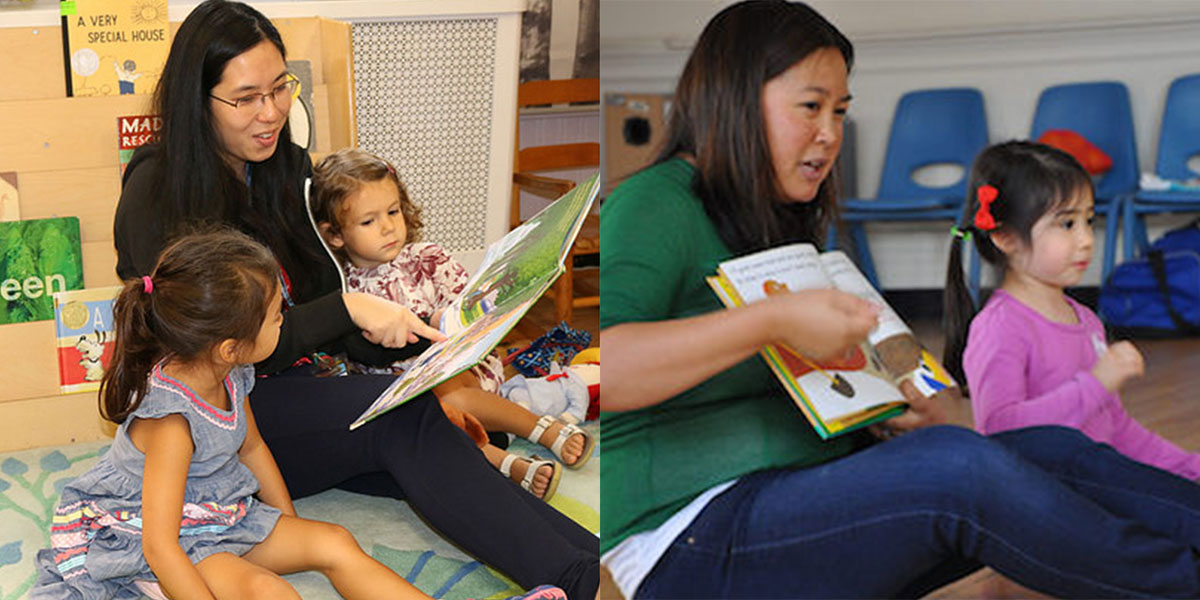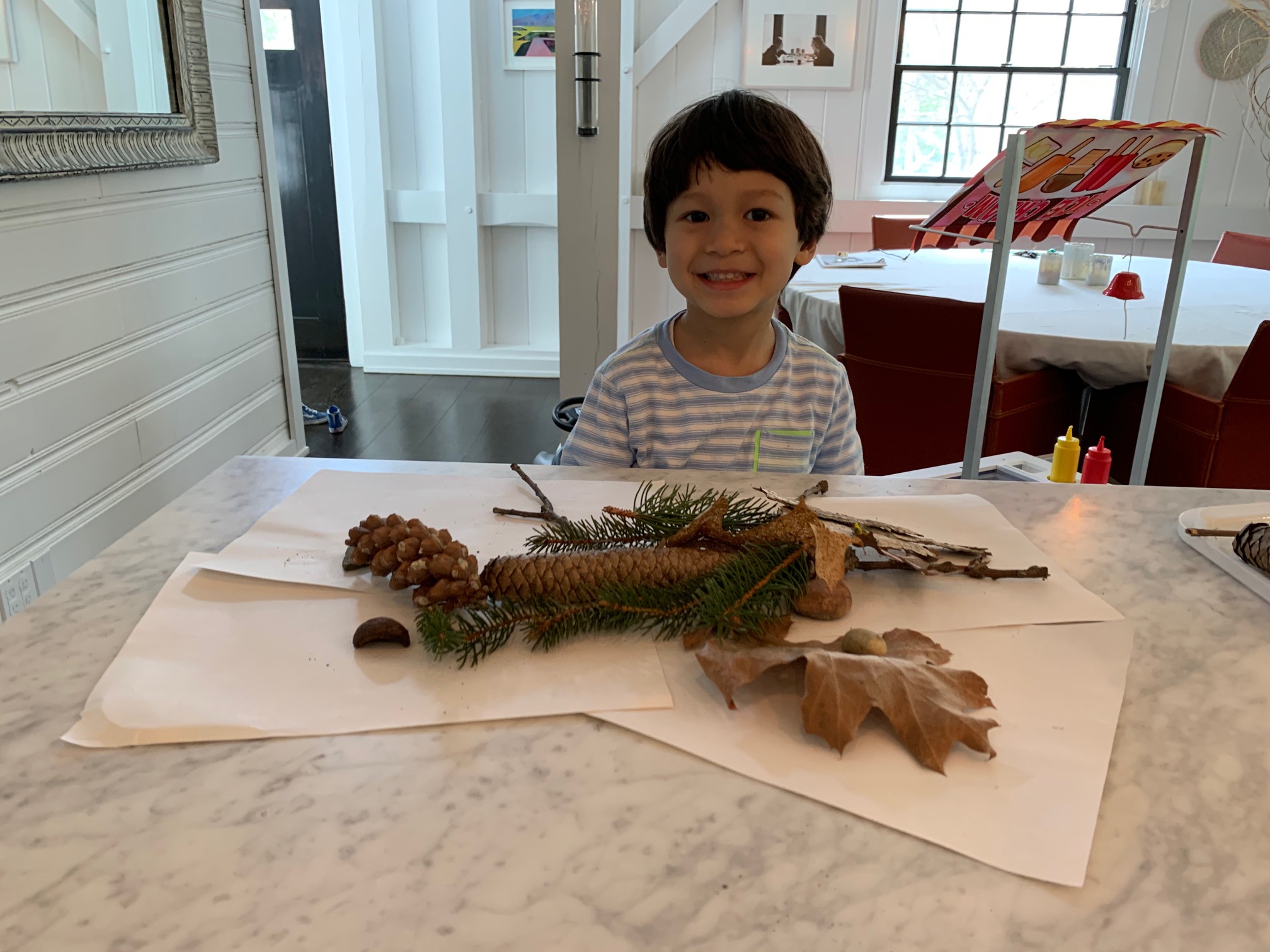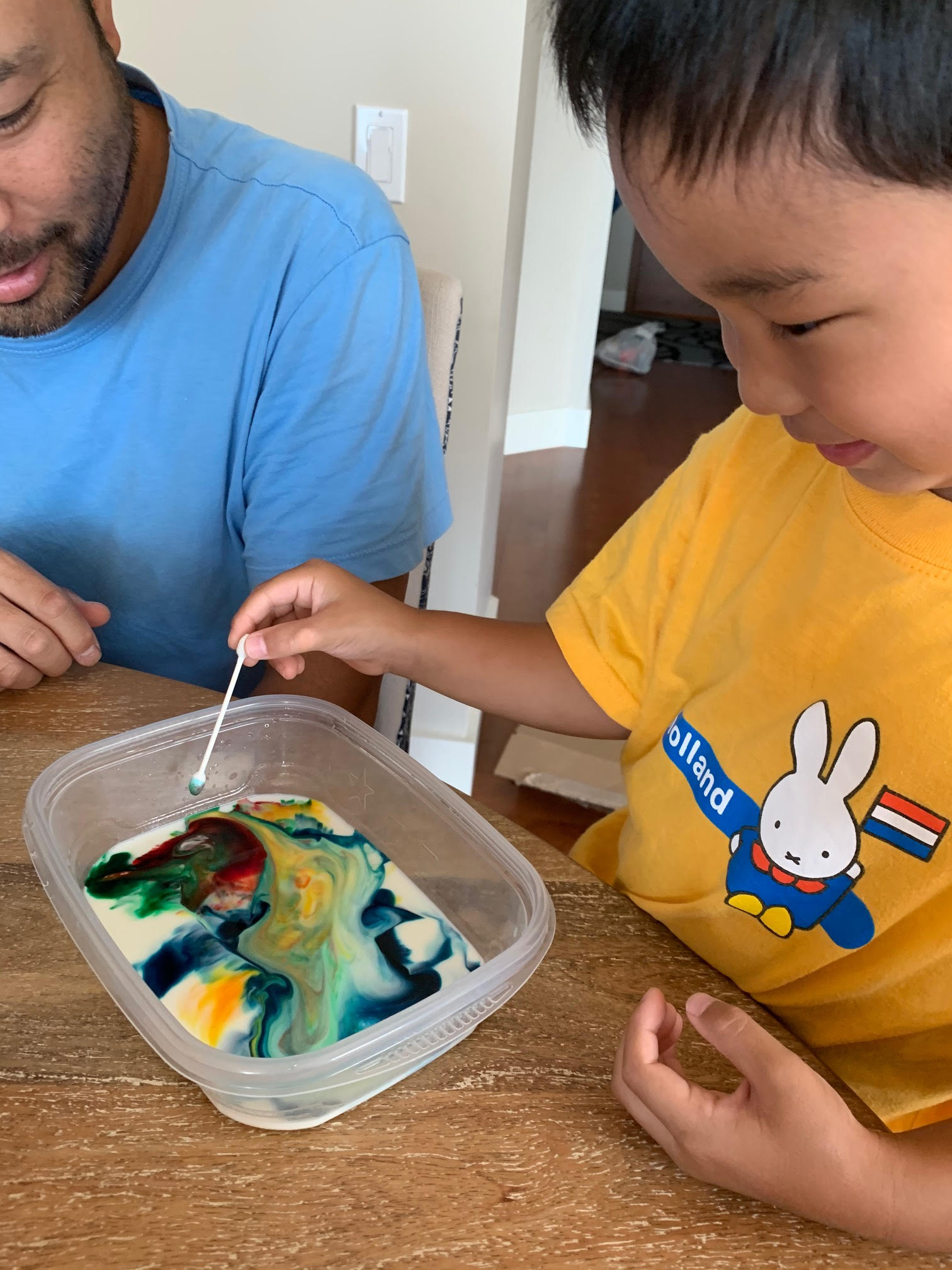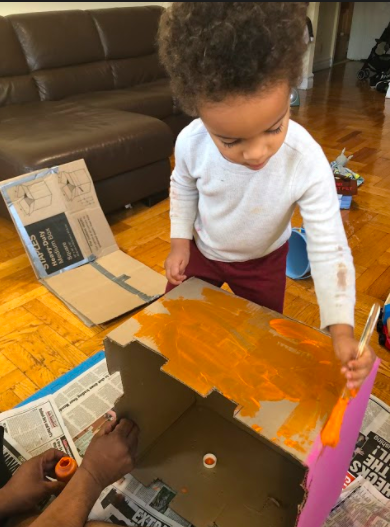Of all levels of education, preschool may be the most fluid — an arena where adults provide routine and structure, but also take their cues from children’s interests and spontaneous play. It’s a challenging enough process in the classroom — but how do you do it online?
The answer arrived at this spring by Teachers College’s Hollingworth Preschool (part of the College’s Hollingworth Center) was: with flexibility and creativity on some fronts, and on others, with an acceptance that there are some real limits to what three- to- five-year-olds can experience and process via a computer screen.
There was no opportunity to prepare the children, no opportunity to say goodbye. We knew that for us to disappear from their lives could be very emotionally unsettling for some children, so we had to act quickly.
— Lisa Wright, Hollingworth Center Director
Within moments after receiving word on Sunday evening, March 8th, that the school would have to close because of the COVID-19 pandemic, Hollingworth Center Director Lisa Wright was on the phone with Heather Pinedo-Burns, then the preschool’s director (she has since left to become head of the Lower School at New York City’s Speyer Legacy School), and its two head teachers, Jenn Lam, a master’s student in counseling psychology, and Marisa Chin-Calubaquib, a doctoral candidate in early childhood education.

“WE HAD TO ACT QUICKLY” Wright was worried about the shutdown’s immediate impact on Hollingworth’s young students — separation, anxiety, fear — but also about her students’ long-term social and emotional development. (Photo: TC Archives)
Clearly, it would not be possible for the school, which was founded in 1984 by TC Professor of Education James Borland, to recreate the enticing bookshelves, building blocks and art supplies in its cheerful classroom on the third floor of Horace Mann Hall. But Wright and her staff believed they not only could, but must offer regular, online programming that would keep the school’s 34 young students feeling safe, connected, engaged and learning.
[Read a story about the Hollingworth Summer Science Camp, which has also gone online.]
Preschool is a time for children to develop across all domains – social, emotional, physical and cognitive. Birth to age five is a very critical period of development. We can only build the foundation once – the children are not going to get this time back. So, it’s absolutely incumbent upon early childhood educators to determine how to do that.
— Lisa Wright, Hollingworth Center Director
The first need identified by the Hollingworth team was to create an online environment that would help the children feel safe and not abandoned after being separated without warning from their teachers and friends at the preschool. “There was no opportunity to prepare the children, no opportunity to say goodbye,” says Wright. “We knew that for us to disappear from their lives could be very emotionally unsettling for some children, so we had to act quickly.”
In a developmental sense, too, there was no time to waste.
“Preschool is a time for children to develop across all domains – social, emotional, physical and cognitive. Birth to age five is a very critical period of development. We can only build the foundation once — the children are not going to get this time back. So, it’s absolutely incumbent upon early childhood educators to determine how to do that.”
The children’s cognitive and physical needs seemed perhaps the easiest to address to first. Teachers could read books and engage with the children online about the texts and pictures, just as they would in the classroom. Even in a cramped, New York apartment, children could dance and sing.

TEACHING TEAM Lam (left) and Chin-Calubaquib worked closely with the children, their parents, and TC students earning field placement credits at Hollingworth. (Photo: TC Archives)
Wright, Pinedo-Burns, Lam and Chin-Calubaquib took Monday and Tuesday of that first week to rough out a three-day program of activities that would get the children through the end of the week, understanding that there would be time later for more detailed planning. On Wednesday, March 11th, Hollingworth began the pilot program on Zoom, with each teacher responsible for her own block of time. The pilot ran through Friday of that week. [Meanwhile, at TC’s Rita Gold Early Childhood Center, which serves the children of faculty and staff, on-site Associate Director Patrice Nichols was engaged in much the same process with her graduate students and staff. Read a story about the Rita Gold Center’s transition online.]
Then during the College’s spring break, Wright and her teachers spent an intensive week designing what Wright calls a hybrid program, consisting of three daily “synchronous” periods, including lunch, in which the children and their teachers could gather simultaneously in a Zoom chat room; plus three periods of “asynchronous” programming, in which the children could choose activities with pre-recorded instructions that the teachers had posted online.
And thus “Hollingworth at Home” was born. Beginning on March 30th, on each weekday morning, the children and their parents or caregivers gathered in small groups online, some children still in pajamas or finishing breakfast. The teachers began by asking the children to describe how they were feeling. Then they read a story. Lunchtime each day afforded another opportunity to gather online and share feelings and concerns. By maintaining a routine similar to the one they’d previously followed in the classroom– for example, daily attendance was taken on Zoom – the teachers sought to foster feelings of safety and predictability.
For some [master's students working at Hollingworth], this is their first experience teaching. They have this digital portfolio now that they wouldn't have had otherwise.
— Jenn Lam,Hollingworth Head Tacher, 4-5s Class
Drawing on her counseling psychology background, Lam also made sure the online program addressed some of the children’s emotional needs, especially those who were anxious about the effect COVID-19 might be having on them and their families. She recorded exercises containing simple mindfulness techniques that the children could use to try to deal with fear or anxiety, and she also posted yoga classes online for children and their adult participants.
These were among the special projects posted on the Hollingworth at Home website, which also included science experiments, movement, math or art projects designed by the teachers, with videotaped instructions. The teachers posted three new projects every day. By April 24th, the children could choose from among 60 projects, all of which were available at any time.
The activities were simple but creative and wide-ranging. Two children appeared at one morning session as a dragon and a pirate, wearing hand-made masks, and explained how they had made them. In another project, the children created self-portraits using everyday kitchen items. Other endeavors involved looking for flowers or birds, or planting seeds in an indoor pot or outdoor space, if children had access to one, and giving the group periodic updates on growth. There were also science experiments, prerecorded readings of stories, and music and dance sessions.
Hollingworth always does a wonderful job of communication, and they have not taken a step back whatsoever in this situation. They’ve kept the connections and the language that they use in the classroom, solicited feedback from us and made improvements based on what we’ve told them.
— Steve Schraibman, parent
Each afternoon, the Hollingworth children reconvened on Zoom, sometimes for virtual “field trips” designed by teachers or parents. One parent arranged for an owlist and his owl to join the group online. A live musical performance that had been scheduled for the classroom was moved online. On another day, the children took a virtual trip to Mystic Aquarium to meet its penguins and beluga whales.
Wright and the teachers regularly surveyed parents and held several online group meetings with them to get feedback on the new program and how their children were faring. Parents who were on leave from their jobs or working from home were encouraged to undertake projects with their children that they might not otherwise have had time for, such as learning to ride a bike, or exploring space with a telescope.

BIRD IN HAND With help from his dad, Alex Schraibman made a bird using materials found in nature during a scavenger hunt. (Photo: Courtesy of the Schraibman family)
“Hollingworth always does a wonderful job of communication, and they have not taken a step back whatsoever in this situation,” said Steve Schraibman, the father of now five-year-old Alex. “They’ve kept the connections and the language that they use in the classroom, solicited feedback from us and made improvements based on what we’ve told them.”
Another positive outcome: the TC master’s students who were earning fieldwork credits at Hollingworth were able to transition online with the school and receive a crash course in online teaching and learning. “For some of them, this is their first experience teaching,” says Lam. “They have this digital portfolio now that they wouldn't have had otherwise.”
Hollingworth at Home concluded its inaugural semester in June to rave reviews. Yet despite all the meticulous planning, regular meetings with parents and constant tweaking, Wright says that one critical element was difficult to provide online: socialization, perhaps pre-K’s raison d’etre.
Most parents send their children to preschool not primarily for skill acquisition or academic instruction (although both of those things happen), but to learn how to play and interact productively with their peers. That experience is very difficult to provide when children can only see one another virtually, in tiny Zoom boxes.
The issues that arose around “mute button etiquette” Illustrate these challenges. In the early days online, the children were grouped in virtual classrooms just as they would have been at school, with about 15 children, one at-home adult for each child and four to six teachers per classroom. The children were muted in those original, large group settings, and that resulted in some competition to unmute and talk, causing some interruptions, miscues and confusion.

SCIENCE GUY Yuto Hari in the midst of a home experiment. (Photo: Courtesy of the Hari family)
“When a kid is muted, they don’t feel like they’re participating,” says Toshiya Hari, the father of 4-year-old Yuto Hari. “Initially, adults would control the mute button, but it was just getting a little bit crazy and out of hand.”
Ultimately, the teachers organized the children into smaller groups and unmuted all the participants. Then the children could speak without scrambling for the mute button, but they had to wait their turn, as they would have at school. That helped reinforce the fundamental social skill of talking in turn — but it also limited the more fluid and complex aspects of social development – the kind of cooperation, problem-solving and conflict resolution required to, say, build a castle together out of wood blocks. Wright compares online interaction to the “parallel play” of young toddlers, who can be happily playing in the same room, but not engaged with one another. “What a videoconference platform does is permit parallel play,” she says. “Remote learning does not foster children’s social development.”
This was a concern for Allan Springer, who by late May was worried that his son Aaron, “a very social person” who was about to turn four, might be edging his Hollingworth friends out of his day-to-day thoughts. As his home stay was approaching its fourth month, Aaron, according to his father, was “lately been more social with adults than he has been with kids. Unfortunately, it’s becoming normal for him.”
Wright shared Springer’s concern, and she says that if Hollingworth continues online in the fall, it will be even more difficult to build social connections among new children who have never met in person. But for now, she views the online programming that Hollingworth developed this spring as a meaningful experience that responds to the global crisis. Hollingworth at Home also provided an opportunity to acquire a few “really quite extraordinary” online tools during the COVID shutdown which the school will keep using, regardless of whether it continues to operate online.

PORTRAIT OF THE ARTIST AS A VERY YOUNG MAN Aaron Springer, at work on a Hollingworth project at home in Queens. (Photo: Courtesy of the Springer family)
One is a virtual library of 40,000 children’s books on the EPIC platform which allows teachers to set up individual accounts for each child and hand-pick titles to drop into virtual book bags for them. “It lets you see what the children are reading,” Wright says. “Also, it allowed me to be mindful of what a child is interested in. One child just really loves science, so I was able to put books about electricity and meteorology in his virtual bookbag. The Hollingworth children have read 3,500 books since I set this up in April.”
What a videoconference platform does is permit parallel play. Remote learning does not foster children’s social development.
— Lisa Wright, Hollingworth Director
Even if Hollingworth, in concert with Teachers College, does open in person, Wright says she also will continue holding the regular online workshops for parents which she started in the spring. Meeting virtually makes it easier for parents to attend without leaving the house and hiring a babysitter, she notes, and the workshops allow teachers and parents to come together “with this really marvelous experience.”
As of mid-July, school plans across the country were still very much a work in progress. In New York City, Mayor Bill de Blasio has advised preschools that they may now reopen following the city’s safety guidelines. New York Governor Andrew Cuomo has announced criteria which each county would use to decide whether to reopen pre-K—12 schools. Around the country, states and local governments are making their own decisions about whether and when to reopen schools.
Online or in person, Wright is clear that whatever path Hollingworth chooses, the school will apply the same thoughtfulness and attention to families’ wellbeing as it did this past semester. Her mantra sounds a lot like the outlook one might try to foster in very young children: “We know that what we’re doing will continue to change, and that is because we’re learning and responding.”
— Patricia Lamiell
[Read the related stories Hands-on Science, at Home about the Hollingworth Science Camp; and Thinking Even Younger about the Rita Gold Early Childhood Center]

